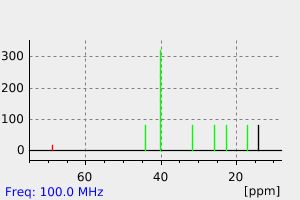1-bromo-1-pentylcyclobutane | 1417621-38-5
中文名称
——
中文别名
——
英文名称
1-bromo-1-pentylcyclobutane
英文别名
1-Bromo-1-pentylcyclobutane
CAS
1417621-38-5
化学式
C9H17Br
mdl
——
分子量
205.138
InChiKey
CPUHSJQHDDWEFK-UHFFFAOYSA-N
BEILSTEIN
——
EINECS
——
-
物化性质
-
计算性质
-
ADMET
-
安全信息
-
SDS
-
制备方法与用途
-
上下游信息
-
文献信息
-
表征谱图
-
同类化合物
-
相关功能分类
-
相关结构分类
计算性质
-
辛醇/水分配系数(LogP):4
-
重原子数:10
-
可旋转键数:4
-
环数:1.0
-
sp3杂化的碳原子比例:1.0
-
拓扑面积:0
-
氢给体数:0
-
氢受体数:0
反应信息
-
作为反应物:描述:dimethylphenylsilylzinc chloride 、 1-bromo-1-pentylcyclobutane 在 NiBr2*diglyme 作用下, 以 四氢呋喃 、 N,N-二甲基乙酰胺 为溶剂, 反应 24.0h, 以73%的产率得到dimethyl(1-pentylcyclobutyl)(phenyl)silane参考文献:名称:通过镍催化的硅亲核试剂与未活化的仲和叔烷基亲电试剂的交叉偶联形成硅-碳键摘要:近年来,已经描述了用于从未活化的烷基亲电试剂形成 CC 键的一系列交叉偶联方法。相比之下,C-杂原子键构建方法的开发进展滞后;例如,没有关于未活化的仲或叔烷基卤化物与硅亲核试剂在金属催化下交叉偶联形成 C-Si 键的报道。在这项研究中,我们解决了这一挑战,确定了一种简单的市售镍催化剂(NiBr2·二甘醇二甲醚)可以在异常温和的条件下(例如,-20°C)实现烷基溴与亲核硅试剂的偶联;特别值得注意的是我们能够使用未活化的叔烷基卤化物作为亲电偶联伙伴,这在交叉偶联化学领域还比较少见。立体化学、相对反应性和自由基陷阱研究与 CX 键裂解的均裂途径一致。DOI:10.1021/jacs.6b03465
-
作为产物:描述:参考文献:名称:通过镍催化的硅亲核试剂与未活化的仲和叔烷基亲电试剂的交叉偶联形成硅-碳键摘要:近年来,已经描述了用于从未活化的烷基亲电试剂形成 CC 键的一系列交叉偶联方法。相比之下,C-杂原子键构建方法的开发进展滞后;例如,没有关于未活化的仲或叔烷基卤化物与硅亲核试剂在金属催化下交叉偶联形成 C-Si 键的报道。在这项研究中,我们解决了这一挑战,确定了一种简单的市售镍催化剂(NiBr2·二甘醇二甲醚)可以在异常温和的条件下(例如,-20°C)实现烷基溴与亲核硅试剂的偶联;特别值得注意的是我们能够使用未活化的叔烷基卤化物作为亲电偶联伙伴,这在交叉偶联化学领域还比较少见。立体化学、相对反应性和自由基陷阱研究与 CX 键裂解的均裂途径一致。DOI:10.1021/jacs.6b03465
文献信息
-
Nickel-Catalyzed Carbon–Carbon Bond-Forming Reactions of Unactivated Tertiary Alkyl Halides: Suzuki Arylations作者:Susan L. Zultanski、Gregory C. FuDOI:10.1021/ja311669p日期:2013.1.16The first Suzuki cross-couplings of unactivated tertiary alkyl electrophiles are described. The method employs a readily accessible catalyst (NiBr2 center dot diglyme/4,4'-di-tert-butyl-2,2'-bipyridine, both commercially available) and represents the initial example of the use of a group 10 catalyst to cross-couple unactivated tertiary electrophiles to form C-C bonds. This approach to the synthesis of all-carbon quaternary carbon centers does not suffer from isomerization of the, alkyl group, in contrast with the umpolung strategy for this bond construction (cross-coupling of a tertiary alkylmetal with an aryl electrophile). Preliminary mechanistic studies are consistent with the generation of a radical intermediate along the reaction pathway.
表征谱图
-
氢谱1HNMR
-
质谱MS
-
碳谱13CNMR
-
红外IR
-
拉曼Raman
-
峰位数据
-
峰位匹配
-
表征信息
同类化合物
(3-溴-1-丙炔-1-基)环丙烷
马杜拉霉素
顺-3,顺-6-1-溴壬二烯
顺,反,顺-1,2,3,4-四(2-溴乙基)环丁烷
金刚烷-2,2-d2
辛烷,1,5-二溴-
苯并噻唑,6-异硫氰酸根合5-甲基-(9CI)
苯(甲)醛,3-甲氧基-4-硝基-
硬脂基溴
硫杂二溴化
癸基溴
甲基环丙基溴化镁
环戊醇1-乙基-3-(苯甲基)-(9CI)
环戊烯-1,3-溴-(7CI,9CI)
环丙烷,1-溴-1-(3,3-二甲基-1-丁炔基)-2,2-二甲基-
环丁基溴
溴甲基环戊烷
溴甲基环己烷
溴甲基环丙烷
溴甲基环丁烷
溴甲基
溴环戊烷-D9
溴己烷-D3
溴己烷
溴化环辛基甲基
溴代环辛烷
溴代环戊烷
溴代环庚烷
溴代环丙烷
溴代异辛烷
溴代异丁烷
溴代叔丁烷-D9
溴代叔丁烷
溴代十四烷-D29
溴代十四烷
溴代十六烷-D33
溴代十六烷
溴代十五烷
溴代十二烷
溴代二十烷
溴乙醛
溴乙烷-D3
溴乙烷-D1
溴乙烷-2-13C
溴乙烷-13C2
溴乙烷-1-13C
溴乙烷-1,1-d2
溴乙烷-1,1,2,2-d4
溴乙烷
溴丙烷-D4







